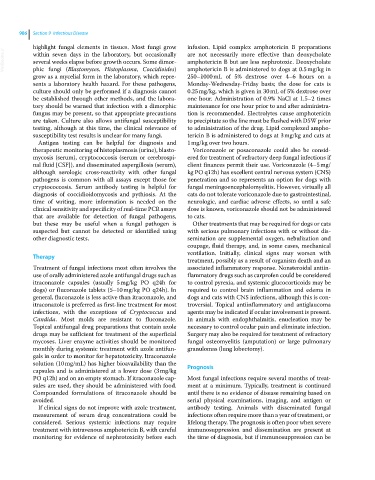Page 1048 - Clinical Small Animal Internal Medicine
P. 1048
986 Section 9 Infectious Disease
highlight fungal elements in tissues. Most fungi grow infusion. Lipid complex amphotericin B preparations
VetBooks.ir within seven days in the laboratory, but occasionally are not necessarily more effective than deoxycholate
amphotericin B but are less nephrotoxic. Deoxycholate
several weeks elapse before growth occurs. Some dimor
phic fungi (Blastomyces, Histoplasma, Coccidioides)
250–1000 mL of 5% dextrose over 4–6 hours on a
grow as a mycelial form in the laboratory, which repre amphotericin B is administered to dogs at 0.5 mg/kg in
sents a laboratory health hazard. For these pathogens, Monday‐Wednesday‐Friday basis; the dose for cats is
culture should only be performed if a diagnosis cannot 0.25 mg/kg, which is given in 30 mL of 5% dextrose over
be established through other methods, and the labora one hour. Administration of 0.9% NaCl at 1.5–2 times
tory should be warned that infection with a dimorphic maintenance for one hour prior to and after administra
fungus may be present, so that appropriate precautions tion is recommended. Electrolytes cause amphotericin
are taken. Culture also allows antifungal susceptibility to precipitate so the line must be flushed with D5W prior
testing, although at this time, the clinical relevance of to administration of the drug. Lipid complexed ampho
susceptibility test results is unclear for many fungi. tericin B is administered to dogs at 3 mg/kg and cats at
Antigen testing can be helpful for diagnosis and 1 mg/kg over two hours.
therapeutic monitoring of histoplasmosis (urine), blasto Voriconazole or posaconazole could also be consid
mycosis (serum), cryptococcosis (serum or cerebrospi ered for treatment of refractory deep fungal infections if
nal fluid [CSF]), and disseminated aspergillosis (serum), client finances permit their use. Voriconazole (4–5 mg/
although serologic cross‐reactivity with other fungal kg PO q12h) has excellent central nervous system (CNS)
pathogens is common with all assays except those for penetration and so represents an option for dogs with
cryptococcosis. Serum antibody testing is helpful for fungal meningoencephalomyelitis. However, virtually all
diagnosis of coccidioidomycosis and pythiosis. At the cats do not tolerate voriconazole due to gastrointestinal,
time of writing, more information is needed on the neurologic, and cardiac adverse effects, so until a safe
clinical sensitivity and specificity of real‐time PCR assays dose is known, voriconazole should not be administered
that are available for detection of fungal pathogens, to cats.
but these may be useful when a fungal pathogen is Other treatments that may be required for dogs or cats
suspected but cannot be detected or identified using with serious pulmonary infections with or without dis
other diagnostic tests. semination are supplemental oxygen, nebulization and
coupage, fluid therapy, and, in some cases, mechanical
ventilation. Initially, clinical signs may worsen with
Therapy
treatment, possibly as a result of organism death and an
Treatment of fungal infections most often involves the associated inflammatory response. Nonsteroidal antiin
use of orally administered azole antifungal drugs such as flammatory drugs such as carprofen could be considered
itraconazole capsules (usually 5 mg/kg PO q24h for to control pyrexia, and systemic glucocorticoids may be
dogs) or fluconazole tablets (5–10 mg/kg PO q24h). In required to control brain inflammation and edema in
general, fluconazole is less active than itraconazole, and dogs and cats with CNS infections, although this is con
itraconazole is preferred as first‐line treatment for most troversial. Topical antiinflammatory and antiglaucoma
infections, with the exceptions of Cryptococcus and agents may be indicated if ocular involvement is present.
Candida. Most molds are resistant to fluconazole. In animals with endophthalmitis, enucleation may be
Topical antifungal drug preparations that contain azole necessary to control ocular pain and eliminate infection.
drugs may be sufficient for treatment of the superficial Surgery may also be required for treatment of refractory
mycoses. Liver enzyme activities should be monitored fungal osteomyelitis (amputation) or large pulmonary
monthly during systemic treatment with azole antifun granulomas (lung lobectomy).
gals in order to monitor for hepatotoxicity. Itraconazole
solution (10 mg/mL) has higher bioavailability than the Prognosis
capsules and is administered at a lower dose (3 mg/kg
PO q12h) and on an empty stomach. If itraconazole cap Most fungal infections require several months of treat
sules are used, they should be administered with food. ment at a minimum. Typically, treatment is continued
Compounded formulations of itraconazole should be until there is no evidence of disease remaining based on
avoided. serial physical examinations, imaging, and antigen or
If clinical signs do not improve with azole treatment, antibody testing. Animals with disseminated fungal
measurement of serum drug concentrations could be infections often require more than a year of treatment, or
considered. Serious systemic infections may require lifelong therapy. The prognosis is often poor when severe
treatment with intravenous amphotericin B, with careful immunosuppression and dissemination are present at
monitoring for evidence of nephrotoxicity before each the time of diagnosis, but if immunosuppression can be

